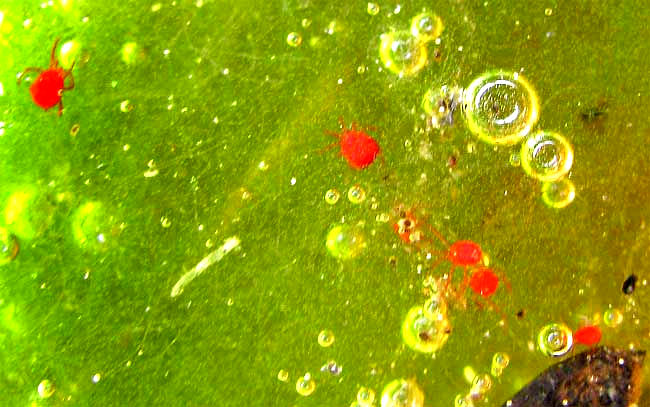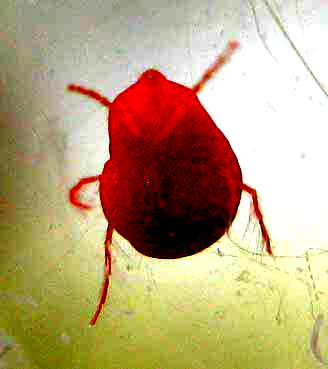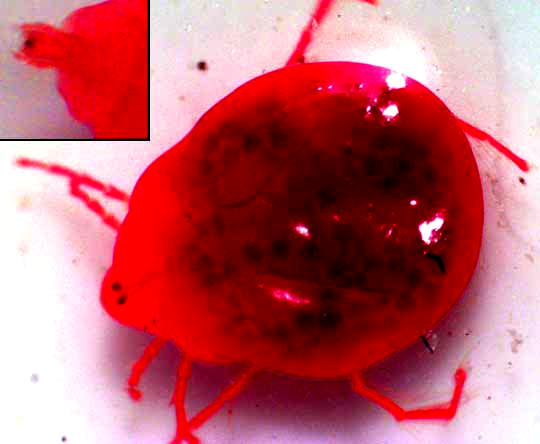Excerpts from Jim Conrad's
Naturalist Newsletter

from the July 21, 2008 Newsletter, after a visit to Land Between The Lakes National Recreation Area in western Kentucky:
LITTLE RED DOTS IN THE ALGAE
With my nose right at the scummy water's edge I saw tiny, red, globular items sailing through the water between algae strands much faster than you'd think such tiny spheres could swim. With sweat and a world of glare in my eyes I couldn't see the blobs well but I knew they were water mites, somewhat related to ticks, and even looking a little like them. My close-up of a patch of red-dotted alga scum shows them suspended in their sparkling, bubbly green galaxy above. Many kinds of water mite exist but I suspect that these are members of the genus HYDRYPHANTES.
I read that water mites metamorphose through three active stages: larva, nymph (a special kind called a deutonymph), and adult. Larvae are distinguished by having six legs. They live free but eventually attach to immature aquatic insects where they become parasitic. I've seen aquatic insect larvae affixed with tiny red dots, so that was what was going on there. Once water-mite larvae engorge on their host they drop off, remain quiet a while, and then metamorphose into deutonymphs, which have eight legs. Deutonymphs as well as adults prey on small crustaceans or aquatic insect eggs and larvae. The deutonymph grows until it metamorphoses into an adult.
In my photo it looks like I have six-legged larvae. My Golden Guide called Pond Life says that adult water mites can reach 0.2 inch long (5 mm) and that's much larger than what's in my photo.
from the January 26, 2014 Newsletter issued from the Frio Canyon Nature Education Center in the valley of the Dry Frio River in northern Uvalde County, southwestern Texas, on the southern border of the Edwards Plateau; elevation ~1750m (~5750 ft); N29.62°, W99.86°; USA
WATER MITE
 In our goldfish bowls containing water, muck and debris from the Dry Frio, the most eye-catching occupant is a tiny animal only about 1mm long (1/16th inch). Though so small, it's conspicuous because of its bright red color. In the Dry Frio's shallow, clear waters you almost always spot one or more of these red specks swimming through the water (not atop it). The bottom side of one crawling up a fishbowl's inner surface is shown at the right.
In our goldfish bowls containing water, muck and debris from the Dry Frio, the most eye-catching occupant is a tiny animal only about 1mm long (1/16th inch). Though so small, it's conspicuous because of its bright red color. In the Dry Frio's shallow, clear waters you almost always spot one or more of these red specks swimming through the water (not atop it). The bottom side of one crawling up a fishbowl's inner surface is shown at the right.
In that picture, notice the long hairs, or setae, on the hind leg, helpful in swimming. A view of the same individual below a dissecting scope, showing eye spots, and dark spots inside the body that possibly are eggs, is shown below:

The inset in that image's upper, left corner shows the mouthparts from below, mouthparts that look more useful for piercing and sucking than for chewing.
This is a water mite, which technically can be referred to as a Hydracarina. The term Hydracarina doesn't apply to a species or even a genus; it's a general term for many families of water mites. About 5000 Hydracarina species are known, but it's assumed that many, many more are to be discovered, since they've been little studied in the tropics. Water mites are not insects of the class Insecta (with six legs), but rather are arachnids, like spiders, of the class Arachnida (with eight legs).
Nearly all water mites occur in freshwater habitats, not marine ones. Most species are carnivorous, seizing upon worms, small crustaceans and small insects, piercing the cuticle of their prey with their mouthparts, then sucking out the juices. Our individual is about normal in size, the smallest species being about half as large (0.5mm) while the largest reach 8mm (5/16ths inch). Like ours, many species are vividly colored, besides red also being yellow and orange. Apparently the bright colors warn fish of the mite's unpalatableness, which probably is due to noxious secretions from their skin glands.
The larval stage of many water mite species is parasitic, often on or inside winged insects, which transport the larvae far from home. I don't know whether our Dry Frio species has a parasitic larval stage or not.
Whatever the secret details of their life history, our brilliantly red water mites are a striking feature of the Dry Frio's shallow, clear water, if you but take the time to sit along the banks awhile, gazing into the water.